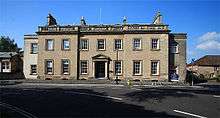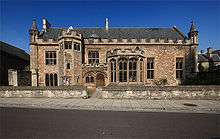Wells Cathedral School
Wells Cathedral School is a co-educational independent school located in Wells, Somerset, England. The school is one of the five specialist musical schools for school-age children in the United Kingdom, along with Chetham's School of Music, the Yehudi Menuhin School, the Purcell School and St. Mary's Music School, Edinburgh. The Head Master, Alastair Tighe, is a member of the Headmasters' Conference.
| Wells Cathedral School | |
|---|---|
 | |
| Address | |
The Liberty , England | |
| Coordinates | 51°12′49″N 2°38′37″W |
| Information | |
| Type | Public school Independent day and boarding Cathedral foundation school |
| Motto | Esto Quod Es ("Be What You Are") |
| Religious affiliation(s) | Church of England |
| Established | c. 909 |
| Chairman of the Governors | The Very Revd. Dr John Davies |
| Head Master | Alastair Tighe |
| Gender | Co-educational |
| Age | 2 to 18 |
| Enrolment | 700 |
| Houses | Ten |
| Colour(s) | Navy, gold |
| Patron | Charles, Prince of Wales |
| Website | https://wells.cathedral.school |
History
With links to a school founded in AD 909,[1] Wells is one of the oldest extant schools in the world. The School admitted girls in 1969 and has over 700 pupils aged between 3 and 18. The School has a musical emphasis and specialises in combining high-level musical tuition with a general academic education, as well as sports.
Situated within the city of Wells, the School's boarding houses line the northern parts of the city and the Music School retains close links with Wells Cathedral. The Vicar's Chapel and Library in Vicars' Close was built c1424-1430. The lower floor was a chapel, with a spiral stair leading up to the library.[2] It is now used by the School.[3]
De Salis House and De Salis Cottage were built in the late 14th century.[4] The Rib was built in the 15th century and is a Grade II* listed building.[5] Cedars House was built in 1758 for Charles Tudway, the Member of Parliament for Wells and now forms part of the school.[6] Claver Morris House was built as a canonical house in 1669 by Dr Claver Morris,[7] while Plumptre dates from 1737 and was built for Dr Francis White.[8] No.11 The Liberty was built as a Canonical house in the mid 18th century and it now forms part of Wells Cathedral Junior School.[9] No 23 The Liberty was built in 1819 for the Chapter Clerk, William Parfitt,[10] and the 15th century Polydor House formerly belonged to the organists.[11]

The red brick Cedars Cottage, which was built as a coachman's cottage the former stables and coach house were built in the mid to late 18th century,[12] around the same time as Mullins.[13] Ritchie House was built a little later around the end of the 18th century or the beginning of the 19th.[14] Ritchie Hall became part of the School on its rebuilding in 1884 but incorporates part of a 12th-century Canon's Barn,[15] while St Andrew's Lodge was built in 1713 as part of a charity school.[16]
Wells Cathedral School is supposed to be the fifth oldest independent school in the country. It cannot be proven, however, that the School has existed continually since the date of its supposed foundation in the tenth century, and there was certainly a hiatus during the 1880s, after which it was refounded.
The current Head Master is Alastair Tighe[17] with Julie Barrow as Head of the Junior School, and Mark Stringer as Director of Music. Tighe has been Head Master since September 2018 and was previously Deputy Head (Academic) at Bedford School where he was for 5 years.
The Royal Family holds links with the school, many of the buildings being opened by Queen Elizabeth, The Queen Mother on 6 July 1979.[18] Queen Elizabeth II visited the school during her Silver Jubilee tour in 1977. The Countess of Wessex visited Wells on 18 October 2007 and has done so several times subsequently, including most recently in September 2019 to help mark the 25th anniversary of the foundation of the Girl Choristers and the establishment of Cedars Hall.[19]
In 1969 it was among the first independent schools in the country to become coeducational when the junior school admitted girls. The following year, girls were admitted to the Senior School and it became fully coeducational.
In 2005, the School was one of fifty independent schools to be found guilty of operating a price-fixing cartel, discovered by The Times, under which schools had made fee increases or decreases concurrently, thus minimising competition.[20] Each school was required to pay a nominal penalty of £10,000 and all agreed to make ex-gratia payments totalling £3 million into a trust designed to benefit pupils who attended the schools during the period in respect of which fee information was shared. The discovery by The Times was made shortly after new Office of Fair Trading directives prohibiting such sharing of information a directive not clearly communicated according to the schools concerned, a fact omitted by many tabloids.[21]
Music

Distinguished musicians visit the School to give masterclasses. The Music School has several main practice areas including the historic Vicars' Close, and caters for specialist, special provision and general musicians. The whole School comprises pre-prep, Junior School, and Senior School which includes a Sixth Form.
The Music School was formerly the house of the Archdeacon of Wells. It was rebuilt by Archdeacon Andrew Holes between 1450 and 1470, possibly retaining some 13th century work and further restoration was undertaken by Edmund Buckle in 1886. It is a Grade II* listed building.[22]
The chorister and choral conductor Peter Stanley Lyons was Director of Music and Deputy Headmaster of Wells Cathedral School, and Master of the Choristers at Wells Cathedral, from 1954 to 1960.[23][24] The choral conductor James William Webb-Jones was Headmaster of Wells Cathedral School from 1955 to 1960.[25]
The School's connection with the Cathedral offers a range of opportunities. There is a School service every Sunday evening and Monday morning in the Cathedral, as well as music concerts. Chapel, chamber and cathedral choir rehearsals and performances are performed in both the cathedral and the Music School. Government funding of £3.5 million was obtained in 2008 to build a new concert hall and classrooms at Cedars Hall.[26]
School Houses
- Boys' Houses
- De Salis (navy tie with gold emblems)
- Mills (lower school day) (navy tie with thin diagonal white stripes) – house no longer used, however the tie was used for lower school boys until 2017
- Cedars (navy tie with green emblems)
- Shrewsbury (navy tie with blue emblems)
- Girls' Houses
- Claver-Morris
- Mary Mitchell (lower school day) – house no longer in use
- Edwards
- Haversham
- Plumptre
- Canon Grange (no longer in use)
- Mixed
- Ritchie (formally navy tie with red emblems) including the annex Brock House, Sixth Form only.
- Junior House
- Beaumont House (co-educational house)
- Former competitive Houses (Lower School House no longer used as of September 2018)
- Carter
- Lewis
- Competitive houses (Junior School)
- Drake
- Livingstone
- Nelson
- Scott

Notable alumni
- Stephen Barton (born 1982), film and video game composer
- David Buckley, composer
- George Bull, Bishop of St David's
- Philip Dukes, violist[27]
- Iestyn Davies, classical countertenor
- Ben Earle of the Shires duo, country singer/songwriter
- Michael Eavis, founder of the Glastonbury Festival[28]
- Emily Eavis, his daughter, co-organiser of the Glastonbury Festival
- Richard Jacques, composer[29]
- Frederick Keel, composer, singer and academic
- Victoria Lyon, member of Escala[30]
- Kris Marshall, actor[31]
- Justin Mortimer, artist[32]
- Malcolm Nash, cricketer[33]
- Danny Nightingale, Olympic gold-medallist
- Bruce Parry, BBC presenter[34]
- David Poore, musician & composer[35]
- Roger Saul (born 1950), businessman, founder of the Mulberry (company) fashion label[36]
- James Turle, musician[37]
See also
- List of Cathedral Schools
- List of the oldest schools in the world
References
- Colchester, L.S.; Quilter, David Tudway; Quilter, Alan (1985). A History of Wells Cathedral School. Wells Cathedral School.
- "The Vicars' Chapel Vicars Close, Wells". historicengland.org.uk. English Heritage. Retrieved 13 January 2009.
- Bush, Robin (1994). Somerset: The complete guide. Wimborne, Dorset: Dovecote Press. pp. 221–222. ISBN 1-874336-26-1.
- "De Salis House and De Salis Cottage". historicengland.org.uk. English Heritage. Retrieved 28 March 2009.
- "The Rib". historicengland.org.uk. English Heritage. Retrieved 28 March 2009.
- "The Cedars". historicengland.org.uk. English Heritage. Retrieved 28 March 2009.
- "Claver Morris House". historicengland.org.uk. English Heritage. Retrieved 28 March 2009.
- "Plumptre". historicengland.org.uk. English Heritage. Retrieved 28 March 2009.
- "No.11 The Liberty". historicengland.org.uk. English Heritage. Retrieved 28 March 2009.
- "No 23 The Liberty". historicengland.org.uk. English Heritage. Retrieved 28 March 2009.
- "Polydor House". historicengland.org.uk. English Heritage. Retrieved 28 March 2009.
- "Cedars Cottage and former stables, coach house and allied buildings around". historicengland.org.uk. English Heritage. Retrieved 28 March 2009.
- "Mullins". historicengland.org.uk. English Heritage. Retrieved 28 March 2009.
- "Ritchie House". historicengland.org.uk. English Heritage. Retrieved 28 March 2009.
- "Ritchie Hall". historicengland.org.uk. English Heritage. Retrieved 28 March 2009.
- "St Andrew's Lodge". historicengland.org.uk. English Heritage. Retrieved 28 March 2009.
- "Head – Alastair Tighe". Wells Cathedral School. Retrieved 22 August 2018.
- "History of Wells Cathedral Choir School". Of Choristers – ancient and modern. Archived from the original on 26 September 2007. Retrieved 4 October 2007.
- "HRH The Countess of Wessex visits Trust". Wells Cathedral School. Archived from the original on 3 March 2012. Retrieved 28 March 2009.
- Halpin, Tony (10 November 2005). "Independent schools face huge fines over cartel to fix fees". The Times. London.
- The Office of Fair Trading: OFT names further trustees as part of the independent schools settlement Archived 10 June 2008 at the Wayback Machine
- "The Music School and attached walls". historicengland.org.uk. English Heritage. Retrieved 28 March 2009.
- Entry for Lyons, Peter Stanley, in Register of Twentieth Century Johnians, Volume I, 1900-1949. St John's College, Cambridge.
- Obituary of P.S. Lyons, in Rutland and Stamford Mercury, Friday, April 20, 2007.
- "WEBB-JONES, James William (1904 - 1965)". Who's Who, Oxford Index. Oxford University Press.
- "£3.5m boost to concert hall bid". This is Somerset. Archived from the original on 27 February 2009. Retrieved 28 March 2009.
- "Patricia Noall". Wells Cathedral School. Retrieved 27 June 2012.
- "Michael Eavis". Bristol University. Retrieved 6 September 2009.
- "Old Wellensian [1991] – Richard Jacques". Retrieved 27 June 2012.
- "Victoria Lyon – Violin". Escala Group. Retrieved 6 September 2009.
- "Kris Marshall". BBC. Retrieved 6 September 2009.
- "She's the Queen - so off with her head". Daily Telegraph. Retrieved 26 September 2018.
- "Cricket at Wells Cathedral School". Schools Cricket Online. Retrieved 6 September 2009.
- "Bruce Parry Profile". Eden. UKTV. Retrieved 6 September 2009.
- "David Poore – biography". Retrieved 10 June 2009.
- "Roger Saul Biography". Kilver Court. Retrieved 19 May 2017.
- "Turle, James". Musical Biographies. Grande Musica. Retrieved 6 September 2009.